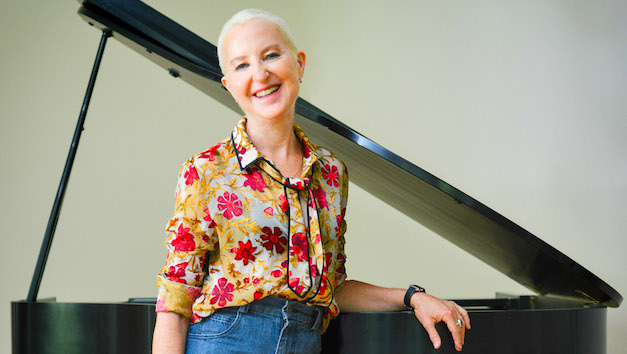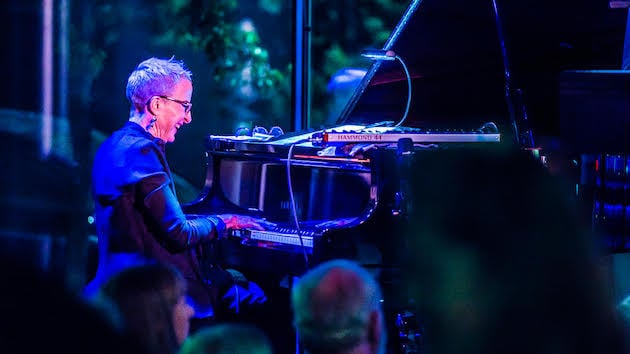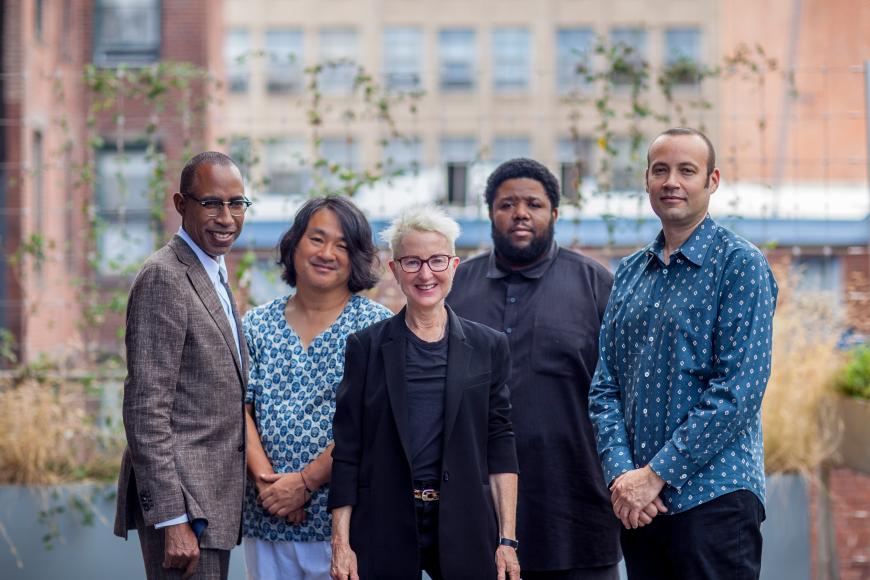
Myra Melford doesn’t need a cast of collaborators to create spellbinding music. Alone at the piano she’s an orchestra, her left hand a thumping bass and rumbling percussion section, her chords gleaming brass, her mesmeric single lines wending to unexpected destinations. Well versed in extended techniques, she’s an inside/out improviser with a deep feel for the blues, Cuban clave, and kindred Latin American grooves. As a composer, she’s a master at scaling forms, equally effective designing tightly constructed miniatures and picaresque, multisectioned sojourns inspired by mythic tales, paintings, and Sufi verse.
Melford doesn’t require collaborators, but what’s made her one of jazz’s most renowned artists is her ability to weave equally powerful and distinct musical personalities into singular ensembles, either under her leadership or as collective endeavors. With some two dozen albums as a leader or co-leader in a discography spanning three decades, she’s created a body of work that’s inextricably enmeshed in a century of jazz practice and unfettered by constricting conventions.

Born in Evanston, Illinois, on January 5, 1957, Melford has often described formative experiences hearing pioneering African-American artists involved with Chicago’s Association for the Advancement of Creative Musicians (AACM), such as pianist Muhal Richard Abrams, Art Ensemble of Chicago saxophonists Joseph Jarman and Roscoe Mitchell, and violinist Leroy Jenkins (who later performed and recorded with Melford and Jarman in the collective trio Equal Interest). While she immersed herself in blues as a teenager studying piano with noted boogie-woogie stylist Erwin Helfer, it wasn’t until she went off to Evergreen State College in Olympia, Washington, that she became smitten with avant-garde jazz and fell under the sway of the AACM innovators.
After several years at Evergreen, she transferred to Seattle’s Cornish College of the Arts to study with pianist Art Lande and bassist Gary Peacock, key figures in jazz’s venturesome movements of the 1960s and’70s. Relocating to New York City in 1984, she found a niche in the roiling Downtown scene. By the end of the decade she’d devised a highly personal vision, expanding on Henry Threadgill’s cellular compositional approach with influences from Caribbean rhythms, classical Indian traditions, Sufi mysticism, and architecture (inspiration gleaned from growing up in a house designed by Frank Lloyd Wright). Over the years she’s expanded her sonic palette with harmonium, melodica, and the occasional prepared piano, tools she wields to open up new terrain for ensemble interaction. Increasingly sought after in new music settings, she’s received commissions from the San Francisco Contemporary Music Players and Chamber Music America.

Based in Berkeley since 2004, when she became a professor in UC Berkeley’s Department of Music, Melford has thrived in California, maintaining an international profile while teaching full time. She’s been awarded a Guggenheim, the Doris Duke Artist Award, and a Doris Duke Residency in conjunction with Yerba Buena Center for the Arts. Her music has been arranged and performed by the Jazz at Lincoln Center Orchestra, and she’s received commissions from the San Francisco Contemporary Music Players and the Other Minds Festival. Some of her recent ensembles include the collective Tiger Trio with bassist Joëlle Léandre and flutist Nicole Mitchell, and a new quintet Fire and Water with guitarist Mary Halvorson, saxophonist Ingrid Laubrock, cellist Tomeka Reid, and drummer Susie Ibarra, which will soon be recording a suite of music inspired by a series of Cy Twombly drawings, Gaeta Set (For the Love of Fire and Water).
Here’s some essential listening:
Now & Now — Myra Melford Trio (Enemy Records) 1992
Melford first gained widespread notice in the early 1990s with her protean trio with bassist Lindsey Horner and drummer Reggie Nicholson. Consisting of six Melford originals, the group’s second album has lost none of its bracing power. From the opening track, the exhilarating “Shout,” the group breathes and bounds together, with Horner’s insistent bow work providing the pungent earth to Melford’s skyward chords. From the beginning she sought out musicians on low-end instruments who could pivot seamlessly from rhythmic support to melodic invention.
Above Blue — The Same River, Twice (Arabesque Recordings) 1999
Drawing on the mystical verse of Persian Sufi poet Rumi, Melford’s quintet The Same River, Twice fords the swift and treacherous currents of her increasingly complex compositions. Bristling with talent, the band features cellist Erik Friedlander, drummer Michael Sarin, Chris Speed on tenor sax and clarinet, and trumpeter Dave Douglas (who co-produced the project). The album centers on the 12-minute title track, a sinuous Eastern-tinged mini-suite, but the revelation is the keyboard-crunching “Yet Can Spring,” her rip-snorting tribute to a key pianistic inspiration, Don Pullen (1941-1995).
The Whole Tree Gone — Be Bread (Firehouse 12 Records) 2009
Flowing out of her increasing immersion in North Indian classical music, Melford’s band Be Bread started as a quartet with either guitarist Brandon Ross or trumpeter Cuong Vu. But with the group’s second release they were in the line up together, along with clarinetist Ben Goldberg, acoustic bass guitarist Stomu Takeishi, and drummer Matt Wilson. Melford’s ability to craft detailed settings that allow the individual players to passionately express themselves and interact within an ever-shifting landscape brilliantly flowers on this project. Densely textured but full of space and light, the music often attains ecstatic intensity without sacrificing clarity and buoyancy.
The Guest House — Trio M (Enja) 2011
The second release by the collective Trio M with drummer Matt Wilson and bassist Michael Dresser, The Guest House captures this jazz supergroup in an expansive mood. An infinitely resourceful accompanist, Wilson leavens the proceedings with his puckish sense of humor. Melford contributes three memorable tunes, including the title track inspired by a meal prepared by Oakland chef and jazz aficionado Paul Canales, co-owner of Duende.
Snowy Egret, 2015
Melford’s main vehicle in recent years has been the quintet Snowy Egret, another majestic ensemble that unleashes some of jazz’s most perspicacious improvisers. In a fascinating case study of bandstand geography tracking with group dynamics, bass guitarist Stomu Takeishi is usually positioned centrally, flanked on stage right by Melford and cornetist Ron Miles and on stage left by drummer Tyshawn Sorey and guitarist Liberty Ellman. Melford clearly delights in Takeishi’s ability to move from front line melodic lead to rhythm section anchor to textural free agent, and Snowy Egret swoops, soars, and glides on his strings.
Melford is often at her most expansive in duo settings, and she’s documented numerous charged encounters, including 2015’s Dialogue with clarinetist Ben Goldberg, 1997’s Eleven Ghosts with drummer Han Bennink, 2014’s Everything Here Is Possible with pianist Alister Spence, and 2007’s Under the Water with pianist Satoko Fujii, Heart Mountain with violinist/violist Tanya Kalmanovitch, and Spark! with alto saxophonist/clarinetist Marty Ehrlich. She hasn’t pursued much work as a sidewoman, with the notable exception of drummer Allison Miller’s Boom Tic Boom, an acclaimed combo that has recorded five albums, most recently 2019’s Glitter Wolf.




